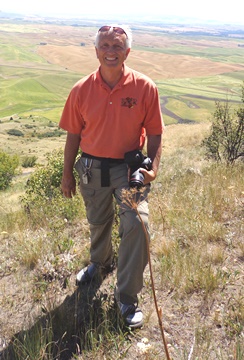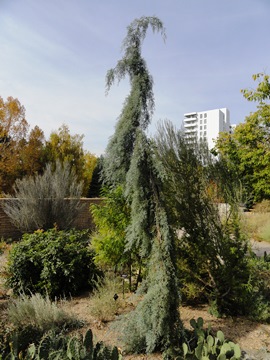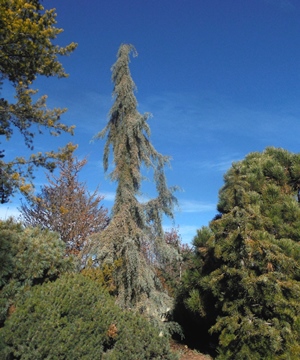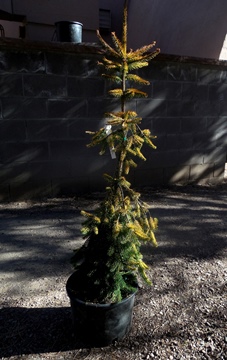Drifts of gold, not drifts of snow!
 Alan Tower
Alan Tower
DENVER Botanic Gardens implies we're a local institution, which is true. But what greater proof of the regional--nay!--national and international reach that we have than when nurserymen from 1,000 miles away maintain a close relationship with us and our collections. I photographed Alan a few years ago when he hosted me on a lecture tour to Spokane. I spent several days exploring his extremely diverse and beautiful nursery and gardens (Tower Perennials and Design), and an unforgettable day on Steptoe Butte where I took this picture, looking at wildflowers (described in the link in the previous sentence). But the relationship between Alan and Denver Botanic Gardens goes back all the way to the 1990s!
 Cupressus arizonica 'Raywood weeping'
Cupressus arizonica 'Raywood weeping'
One day I got a call from Alan saying he was driving into town and wanted to donate two unique specimens of Cupressus arizonica 'Raywood weeping' to our collections. I was surprised to see the size and splendor of the plants, and they were subsequently planted, one in Dryland Mesa (picture above) and another in the Dwarf Conifer Collection. Both have since almost doubled in size and are a pride and joy of our collections. As I walk around the Gardens every day or so, I inevitably walk by one or both of these, and when I do, I think of Alan and his surprise appearance years ago.
Here's a picture of the other specimen I took today:
 Cupressus arizonica 'Raywood weeping'
Cupressus arizonica 'Raywood weeping'
There are few conifers more dramatic or entertaining. Kids see them and say they look like Dr. Seuss characters. They are rare enough I've never seen them in another public garden (but then perhaps I haven't looked carefully enough?).
Last week I got a call from Alan: "Is Chihuly still going on?" He had planned a trip to Canyon Country and realized he might swing by and visit en route--just a few hundred mile diversion is all. He was joined by a friend, Miles Stookey, who had never visited the Gardens before. They drove straight through after Thanksgiving dinner, arriving in the morning last Friday--and they proceeded to spend the day taking hundreds of photographs throughout the Gardens. They were elated with the sculptures, the gardens--and they did not come empty handed. This time, Alan brought Picea abies 'Gold Drift', a deep golden form of the European spruce which he says will make 'Raywood weeping' pale by contrast! Below you see his gift--which has not yet been planted (but soon will be I think).
 Picea abies 'Gold Drift'
Picea abies 'Gold Drift'
People often ask me, where do plants at Denver Botanic Gardens come from? A large proportion are of course from nurseries, garden centers and greenhouses in and around Denver. Many of our finest treasures come from Index Seminum--the centuries old exchange between botanic gardens. Many of our most precious plants are collected by staff and associates on mountains and plains all over the world. But some of our choicest specimens are gifts like this, from talented nurserymen and collectors all over the United States who care about Denver Botanic Gardens, and want to see our collections prosper.
Alan is just one such plantsman, who has traveled thousands of miles over the decades to enjoy our Gardens, and to leave his mark upon them. If it takes a village to raise a child, it takes a World of plantsmen to make a botanic garden.
Add new comment